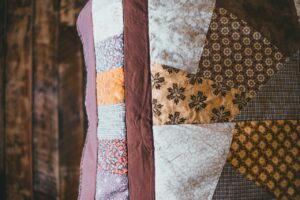
Patchwork, a centuries-old art form, has experienced a resurgence in recent years as homeowners and interior designers rediscover its unique charm and versatility. With roots in both necessity and creativity, patchwork has evolved from a simple means of repurposing fabric scraps into a sought-after design element in modern home interiors. This article will explore the rich history of patchwork, its various techniques, and how to incorporate this timeless art form into your living space.
The History of Patchwork
Patchwork dates back thousands of years, with evidence of its practice found in ancient Egyptian tombs, as well as in the traditional textiles of various cultures around the world. Originally, patchwork was born out of necessity, as people sought ways to extend the life of worn-out garments and linens by sewing small pieces of fabric together. Over time, however, patchwork became an expressive art form, with intricate patterns and designs showcasing the skill and creativity of the maker.
Techniques and Styles
There are numerous patchwork techniques and styles, each with its unique characteristics and visual appeal. Some of the most popular methods include:
- Traditional patchwork: This technique involves sewing small pieces of fabric, or “patches,” together to form a larger pattern. The resulting quilt top can be layered with batting and backing fabric, then quilted together to create a warm and cozy quilt or bedspread;
- Appliqué: In appliqué, patches of fabric are sewn onto a larger background fabric, creating a layered effect with various shapes and motifs. This technique allows for more intricate designs and artistic freedom, as virtually any shape can be created and combined with other elements;
- Crazy quilting: Originating in the Victorian era, crazy quilting is characterized by irregularly shaped patches, often embellished with embroidery, beads, and other decorative elements. This eclectic style often features rich, luxurious fabrics such as velvet and silk, resulting in a visually stunning and tactile piece;
- Log cabin: In this traditional patchwork technique, strips of fabric are arranged around a central square, forming a concentric design resembling the construction of a log cabin. This style is known for its geometric simplicity and striking visual effect, with endless variations in color and layout.
Incorporating Patchwork into Your Home
Patchwork can add warmth, texture, and a touch of history to your home interior. Here are some ideas for incorporating this timeless art form into your living space:
- Quilts and bedspreads: A patchwork quilt or bedspread can be a focal point in a bedroom, adding color and visual interest. Choose a design that complements your existing décor, or opt for a more eclectic look by mixing various patterns and fabrics;
- Wall hangings: Patchwork wall hangings can add a unique and artistic touch to any room. Select a piece that reflects your personality or showcases a particular theme, such as nature or geometric patterns;
- Cushions and throws: Patchwork cushions and throws can instantly update your living room or bedroom, adding texture and a pop of color. These versatile accessories can be easily switched out to refresh your décor or to suit the changing seasons;
- Upholstery: For a bold statement, consider upholstering of furniture, such as an armchair or ottoman, in patchwork fabric. This not only adds a touch of whimsy and character to your space but also creates a one-of-a-kind focal point that showcases your unique style;
- Table linens: Incorporate patchwork table runners, placemats, or tablecloths into your dining area for a charming and rustic touch. These handmade items can be an excellent conversation starter and lend a warm, inviting atmosphere to your gatherings;
- Rugs: Patchwork rugs, created by sewing together various fabric scraps or smaller rug pieces, can add color, texture, and visual interest to your floors. Choose a color palette that complements your room’s décor, or opt for a more eclectic and vibrant design to create a statement;
- DIY projects: If you’re feeling inspired and creative, try your hand at making your patchwork items. This can be a fun and rewarding way to personalize your home while also giving new life to fabric scraps and old garments.

Tips for Choosing Patchwork Elements
When selecting patchwork pieces or fabrics for your home, consider the following tips:
- Color harmony: Choose colors that work well together and complement your existing décor. You can opt for a monochromatic scheme with varying shades of a single color or create a more dynamic look by combining complementary or contrasting hues;
- Scale and pattern: Mix and match different scales of patterns and motifs to add depth and visual interest. Combining larger, bolder patterns with smaller, more delicate designs can create a balanced and harmonious look;
- Quality: Opt for high-quality fabrics that can withstand daily wear and tear. This is particularly important for items such as quilts, upholstery, and rugs, which are subject to more frequent use;
- Personal style: Ultimately, choose patchwork elements that reflect your personality and taste. Embrace your creativity and don’t be afraid to experiment with different patterns, textures, and styles.
Patchwork is a timeless art form that can add warmth, charm, and personality to your home interiors. By understanding its rich history and various techniques, you can select the perfect patchwork elements to enhance your living space. Whether you prefer traditional patchwork quilts, eclectic crazy quilting, or geometric log cabin designs, incorporating this versatile art form into your home is an excellent way to celebrate craftsmanship, creativity, and the enduring appeal of handmade textiles.

 Explore the dynamic realm of
Explore the dynamic realm of 








